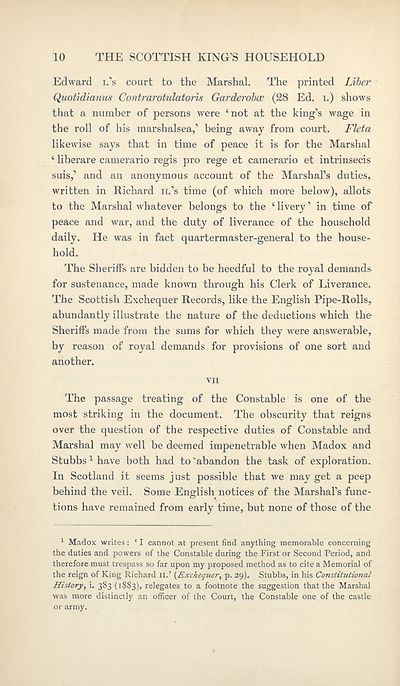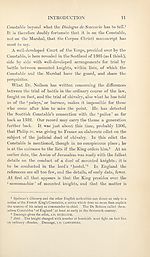Download files
Complete book:
Individual page:
Thumbnail gallery: Grid view | List view

10
THE SCOTTISH KING’S HOUSEHOLD
Edward i.’s court to the Marshal. The printed Liber
Quotidianus Contrarotulatoris Garderobas (28 Ed. i.) shows
that a number of persons were ‘not at the king’s wage in
the roll of his marshalsea,’ being away from court. Fleta
likewise says that in time of peace it is for the Marshal
‘ liberare camerario regis pro rege et camerario et intrinsecis
suis,’ and an anonymous account of the Marshal’s duties,
written in Richard n.’s time (of which more below), allots
to the Marshal whatever belongs to the ‘ livery ’ in time of
peace and war, and the duty of liverance of the household
daily. He was in fact quartermaster-general to the house¬
hold.
The Sheriffs are bidden to be heedful to the royal demands
for sustenance, made known through his Clerk of Liverance.
The Scottish Exchequer Records, like the English Pipe-Rolls,
abundantly illustrate the nature of the deductions which the
Sheriffs made from the sums for which they were answerable,
by reason of royal demands for provisions of one sort and
another.
VII
The passage treating of the Constable is one of the
most striking in the document. The obscurity that reigns
over the question of the respective duties of Constable and
Marshal may well be deemed impenetrable when Madox and
Stubbs1 have both had to 'abandon the task of exploration.
In Scotland it seems just possible that we may get a peep
behind the veil. Some English notices of the Marshal’s func¬
tions have remained from early time, but none of those of the
1 Madox writes: ‘ I cannot at present find anything memorable concerning
the duties and powers of the Constable during the First or Second Period, and
therefore must trespass so far upon my proposed method as to cite a Memorial of
the reign of King Richard II.’ (Exchequer^ p. 29). Stubbs, in his Constitutional
History, i. 383 (1883), relegates to a footnote the suggestion that the Marshal
was more distinctly an officer of the Court, the Constable one of the castle
or army.
THE SCOTTISH KING’S HOUSEHOLD
Edward i.’s court to the Marshal. The printed Liber
Quotidianus Contrarotulatoris Garderobas (28 Ed. i.) shows
that a number of persons were ‘not at the king’s wage in
the roll of his marshalsea,’ being away from court. Fleta
likewise says that in time of peace it is for the Marshal
‘ liberare camerario regis pro rege et camerario et intrinsecis
suis,’ and an anonymous account of the Marshal’s duties,
written in Richard n.’s time (of which more below), allots
to the Marshal whatever belongs to the ‘ livery ’ in time of
peace and war, and the duty of liverance of the household
daily. He was in fact quartermaster-general to the house¬
hold.
The Sheriffs are bidden to be heedful to the royal demands
for sustenance, made known through his Clerk of Liverance.
The Scottish Exchequer Records, like the English Pipe-Rolls,
abundantly illustrate the nature of the deductions which the
Sheriffs made from the sums for which they were answerable,
by reason of royal demands for provisions of one sort and
another.
VII
The passage treating of the Constable is one of the
most striking in the document. The obscurity that reigns
over the question of the respective duties of Constable and
Marshal may well be deemed impenetrable when Madox and
Stubbs1 have both had to 'abandon the task of exploration.
In Scotland it seems just possible that we may get a peep
behind the veil. Some English notices of the Marshal’s func¬
tions have remained from early time, but none of those of the
1 Madox writes: ‘ I cannot at present find anything memorable concerning
the duties and powers of the Constable during the First or Second Period, and
therefore must trespass so far upon my proposed method as to cite a Memorial of
the reign of King Richard II.’ (Exchequer^ p. 29). Stubbs, in his Constitutional
History, i. 383 (1883), relegates to a footnote the suggestion that the Marshal
was more distinctly an officer of the Court, the Constable one of the castle
or army.
Set display mode to:
![]() Universal Viewer |
Universal Viewer | ![]() Mirador |
Large image | Transcription
Mirador |
Large image | Transcription
Images and transcriptions on this page, including medium image downloads, may be used under the Creative Commons Attribution 4.0 International Licence unless otherwise stated. ![]()
| Scottish History Society volumes > Series 1 > Miscellany of the Scottish History Society (Second volume) > (25) Page 10 |
|---|
| Permanent URL | https://digital.nls.uk/126947288 |
|---|
| Attribution and copyright: |
|
|---|
| Description | Over 180 volumes, published by the Scottish History Society, containing original sources on Scotland's history and people. With a wide range of subjects, the books collectively cover all periods from the 12th to 20th centuries, and reflect changing trends in Scottish history. Sources are accompanied by scholarly interpretation, references and bibliographies. Volumes are usually published annually, and more digitised volumes will be added as they become available. |
|---|


